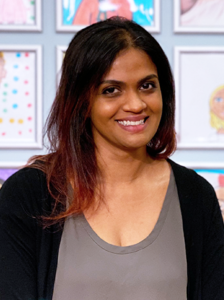Scout Badge Labs | Play, Tinker, Explore!

Scout Badge Labs | Play, Tinker, Explore!

By Sweta Sobrin, DCM’s Sr. Manager for Early Learning & Family Engagement

“And then the dinosaur chomps all the buildings, and the buildings don’t fall over because they are made of special steel, and then fairies fly out and…”
If you have ever been part of a child’s dramatic play, you have inevitably witnessed the loose storytelling structure that is a hallmark of pretend play. As an adult, it may seem difficult to comprehend the winding paths of a seemingly incoherent story. After all, we often live in a world of concrete facts and logical reasoning. It may even be uncomfortable to drop storylines, introduce new characters that evolve at a breakneck pace, and simultaneously create and solve problems. However, a child’s ability to change scenarios proves invaluable in the growth and development of many important skills, including problem-solving and exploring social dynamics.
In the world of improv, the concept of “yes, and” implores a player to accept what another player has stated and then expand on that line of thinking. “Yes, and-ing” turns play into a collaborative experience. For adults and children alike, creativity in a group setting requires vulnerability. We often worry about the validity of our ideas, or being rejected. However, the positive effects of evolving imaginative play far outweighs the feelings of embarrassment we might hold.
Here are some ways to dive, wholeheartedly, into dramatic play!
Set ground rules
At the beginning of playtime, review the “rules” of play. Collaboratively come to an agreement about what is and is not acceptable conduct. Children are more apt to follow rules if they were involved in the creation of the rules, and uphold a sense of fairness they helped create. These rules address practical things, like safety, but also can define how you will accept and share ideas. Although it might not always seem like it, children like boundaries that clearly outline the things they are allowed to do. Use positive language like, “We will listen to each other,” versus “No screaming at each other” or “We will accept each other’s ideas,” versus “You can’t do whatever you want”.
Say Yes!

Collaborative play relies on effective two-way communication. In addition to modeling positive ways to accept each other’s suggestions, this is a good time to model how to handle disappointment. Address the difference between the activity and the company by saying something like, “Hmm…you want to drive cars through this city we built. Playing cars is not my favorite thing but I like when we work together. Let’s drive cars now and then add people!” This type of phrasing models how to express disappointment in a healthy way, and redirect the conversation to address the intention of this activity, which is to play and listen to each other. Adding a suggestion at the end shows that you accept the idea and are looking forward to continuing to play together.
Be Silly
Loosen up! As adults, we naturally lose touch with our ability to play and live in a world that is weird and silly. Lower your guards a bit and step into a world of pretend play where dogs can fly and you can take baths in ice cream. Connect with the part of you that is still curious about what the world means. Be a partner in your child’s play by meeting them where they are, both figuratively and literally. If they are grocery shopping on Jupiter, so are you!
Use Props!

Items around the house can fulfill multiple roles. Leftover paper towel tubes could be a telescope, a rolling pin, a trumpet, a skyscraper…the possibilities are truly endless! Enriching your play with everyday items encourages flexible thinking, spontaneity, and creativity! Be sure to use language to describe what your item is becoming. For example, “This spatula is my magic wand!!” By verbalizing your intention, you are fostering effective communication skills and modeling how to share ideas.
Say YES to play!
About Sweta

Sweta has extensive experience in Early Learning Centers including leadership positions. She also has provided educator training and coaching for Early Childhood Educators in a variety of contexts including helping scientists engage children in STEM topics.
“I am beyond thrilled to part of a team of creative, passionate, and responsive professionals who fully believe in the power of play,” shared Sweta. “I am eager to implement DCM’s philosophy of joyful discovery and learning to directly strengthen family connections and build lasting relationships in the community.”

